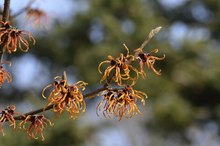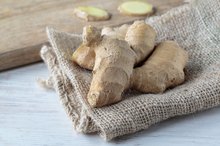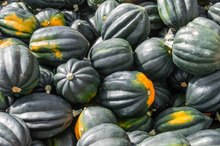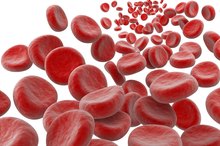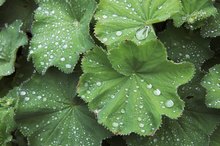Herbs That Promote Blood Clotting
When you cut yourself or scrape the skin, the blood will flow freely at first, then slow and begin the process of forming a clot. Eventually the injury will scar over and heal. Large, deep cuts that lose blood easily or injuries to arteries can be very dangerous. Herbs have been used traditionally in the healing process to help stop bleeding. You should not use herbs without first consulting a health care professional.
How Blood Clots
The process by which your body forms a blood clot is amazingly complex. When you cut yourself, the blood vessels in the area constrict, slowing the blood flow. Platelets are activated by a substance called thrombin and begin to gather at the site of injury to form a temporary plug. Platelets release a number of substances that begin the clotting process. The next step is the actual formation of a clot, which is composed of fibrin, platelets and red blood cells. In addition to platelets and fibrin, the clotting process involves 13 different clotting factors.
- The process by which your body forms a blood clot is amazingly complex.
- The next step is the actual formation of a clot, which is composed of fibrin, platelets and red blood cells.
Alfalfa
Herbal Remedies for Venous Leg Ulcer Pain
Learn More
In order for an herb to promote blood clotting, it must strengthen a clotting factor directly or otherwise promote the effect of one or more clotting factors, platelets or thrombin. Plants and herbs that are high in vitamin K can promote blood clotting. One of these herbs is alfalfa, which contains vitamins, minerals and eight essential amino acids as well as vitamin K. Alfalfa is so effective at promoting blood clotting that it can interfere with the action of the anticoagulant warfarin – brand name Coumadin. Don't use alfalfa without consulting a health care professional.
- In order for an herb to promote blood clotting, it must strengthen a clotting factor directly or otherwise promote the effect of one or more clotting factors, platelets or thrombin.
- One of these herbs is alfalfa, which contains vitamins, minerals and eight essential amino acids as well as vitamin K. Alfalfa is so effective at promoting blood clotting that it can interfere with the action of the anticoagulant warfarin – brand name Coumadin.
Yarrow
Yarrow was named for the mythical Greek hero Achilles, who used the plant to heal his soldiers’ bleeding wounds. It was traditionally used for wounds and minor bleeding. Certified Chinese Herbalist Lisl Meredith Huebner reports that yarrow, Achillea millefolium, is effective for stopping bleeding 2. It can be used to stop a nose bleed or bleeding cut. You should chew a fresh leaf and apply it to the wound. Don't use yarrow without consulting a health care professional.
- Yarrow was named for the mythical Greek hero Achilles, who used the plant to heal his soldiers’ bleeding wounds.
- Certified Chinese Herbalist Lisl Meredith Huebner reports that yarrow, Achillea millefolium, is effective for stopping bleeding 2.
Goldenrod
Does Garlic Help Raise Platelet Count?
Learn More
Goldenrod is used traditionally for internal bleeding, which implies it has the ability to stop bleeding, but the University of Maryland Medical Center cautions that it should not be used on an open wound. Herbs can cause side effects, so you should not use herbs for any medical condition without consulting a health care professional.
Related Articles
References
- HerbalRemediesInformation.com: Alfalfa Herb
- Herbalisl.blogspot.com: Yarrow (Achillea millefolium)
- The Medical BioChemistry Page: Blood Coagulation; Michael W King; August 2011
- Ali SI, Gopalarkrishnan B, Venkatesalu V. Pharmacognosy, phyochemistry and pharmacological properties of Achillea millefolium L.: A review. Phytotherapy research: PTR. 2017 Aug;31(8):1140-1161. DOI: 10.1002/ptr.5840.
- Altinterim B, Danabas D, Aksu O. The effects of common yarrow (Achillea millefolium Linnaeus), cinnamon (Cinnamomum zeylanicum Blume) and rosemary (Rosemarinus officianalis Linnaeus) hydrosols on the some immunological and hematological parameters of common carp (Cyprinus carpio L., 1758). Cellular and molecular biology. 2018 Nov 30;64(14):19-24.
- De Sousa DP, de Almeida Soares Hocayen P, Andrade LN, Andreatini R. A systemic review of the anxiolytic-like effects of essential oils in animal models. Molecules. 2015 Oct 14;20(10):18620-60. DOI: 10.3390/molecules201018620.
- Dorjsembe G, Lee HJ, Kim M, et al. Achillea asiatica extract and its active compounds induce cutaneous wound healing. Journal of ethnopharmacology. 2017 Jul 12;206:306-314. DOI: 10.1016/j.jep.2017.06.006.
- Hajhashemi M, Ghanbari Z, Movahedi M, et al. The effect of Achillea millefolium and Hypericum perforatum ointments on episiotomy wound healing in primiparious women. The journal of maternal-fetal & neonatal medicine. 2018 Jan;31(1):63-69. DOI: 10.1080/14767058.2016.1275549.
- Mohammadhosseini M, Sarker SD, Akbarzadeh A. Chemical composition of the essential oils and extracts of Achillea species and their biological activities: A review. Journal of ethnopharmacology. 2017 Mar 6;199:257-315. DOI: 10.1016/j.jep.2017.02.010.
- Moradi MT, Rafienian-Koupaei M, Imani-Rastabi R, et al. Antispasmodic effects of yarrow (Achillea millefolium L.) extract in the isolated ileum of rat. African journal of traditional, complementary, and alternative medicines. 2013 Oct 3;10(6):499-503. eCollection 2013.
Writer Bio
Beth Greenwood is an RN and has been a writer since 2010. She specializes in medical and health topics, as well as career articles about health care professions. Greenwood holds an Associate of Science in nursing from Shasta College.
